Plan checklist
Gervais
80 Lacroix Bay Rd, Westmeath, Ottawa River
Planting plan created by Watersheds Canada
Funded by • Department of Fisheries and Oceans Canada •
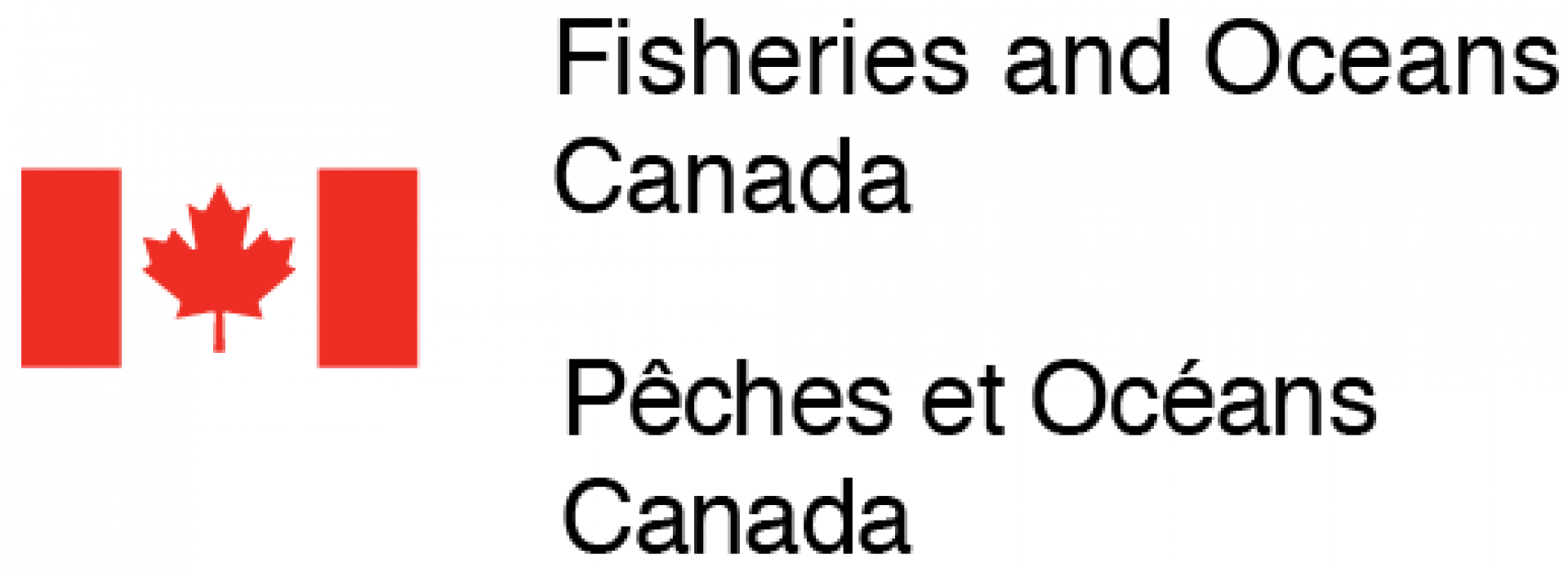
Schedule A:
Plants & Property
Land Characteristics
This planting plan is designed based on the land characteristics identified during the day of the site visit. Plants are chosen according to the soil and light conditions on your property. The number of plants chosen for each planting compartment takes into account the square metre area of the space, as well as the amount of current vegetation cover. Your property is part of ecoZone: 4a
Land Characteristics by Compartment
| Length | Width | Area | pH | Soil | Moisture | Light | Height | |
|---|---|---|---|---|---|---|---|---|
| A | 6.5m | 4m | 26m2 | sandy, loamy | normal | full sun, partial sun | max 3m | |
| B | 12m | 4m | 48m2 | sandy, loamy | normal | full sun, partial sun | max 1.5m | |
| C | 15m | 4m | 60m2 | sandy, loamy | normal | full sun, partial sun | max 3m | |
| 33.5m | 4m | 134m2 |
Plant Selection Summary
The following shrubs and trees are chosen for their suitability and survivability given the current soil and light conditions in each compartment on your property, as well as preferable features.
| Plant Species | A | B | C | Potted | Bareroot | Wildflower |
|---|---|---|---|---|---|---|
| Black Chokeberry | 3 | 3 | 4 | 10 | ||
| Bush Honeysuckle | 3 | 4 | 4 | 11 | ||
| Red Osier Dogwood | 5 | 8 | 6 | 19 | ||
| Saskatoon Serviceberry | 4 | 3 | 4 | 3 | 8 | |
| Black Elderberry | 10 | 3 | 13 | |||
| Black-Eyed Susan | 4 | 4 | ||||
| Common Milkweed | 3 | 6 | 9 | |||
| Wild Bergamot | 3 | 3 | ||||
| Subtotal | 15 | 38 | 27 | 24 | 40 | 16 |
| Totals | 80 | |||||
Plant Information
The following table summarizes key information about each plant selected for your property.
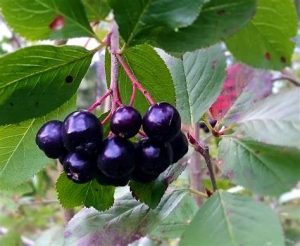
|
Black ChokeberryHeight: 1-3m
The Black Chokeberry is a medium sized deciduous shrub that typically grows between 1-3m with edible fruit. This species requires full sun to partial shade and can tolerate soil conditions from loamy and moist to rocky and dry. Naturally, Black Chokeberry is found in wet wooded areas such as; swamps, along shorelines, and within forest understory. This species is multi-stemmed, and forms thickets from stems which arise from the roots. Leaves are simple, growing alternately along the branch turning a bold red to orange during the fall. During spring, clusters of showy, white flowers appear turning into dark purple berries by fall. This species is resistant to drought, insects, pollution, and disease. The Black Chokeberry is often cultivated as an ornamental plant and food product. Additionally, this species is useful for bank stabilization and erosion control applications.
|
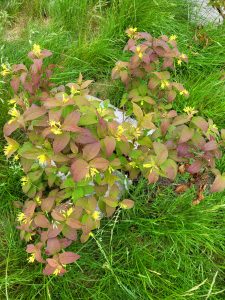
|
Bush HoneysuckleHeight: 1m
The Bush Honeysuckle is a small, hardy, deciduous shrub that rarely grows taller than 1 m in height. The leaves are simple, oppositely arranged, ovate shaped, and have finely toothed margins. During the spring and summer, the leaves are dark green in colour, then in the fall they take on a variety of colours ranging from a deep purple to light yellow. The flowers are small, showy, yellow to orange colored, trumpet shaped, appear in clusters on the tips of branches, and bloom between June and July. The flowers are beneficial to pollinator species, including hummingbirds and butterflies. The roots of the Bush Honeysuckle are fibrous, giving it the ability to form thickets and making it an ideal shrub to plant for erosion control.
|
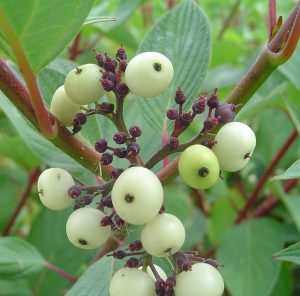
|
Red Osier DogwoodHeight: 1.5-4m
The Red Osier Dogwood is a medium-sized, deciduous shrub native throughout Northern and Western North America which typically grows to 1.5-4m. This species is multi-stemmed with numerous erect and ascending bright red branches that create a loose and spreading form. Leaves produced are simple, two-toned with a dark green upper side and light green underside. They are arranged opposite each other along the branches. During the fall, the foliage turns a brilliant red to dark purple. Clusters of small, creamy white flowers form on the terminal ends of the branches between June and July. The Red Osier Dogwood produces blueish-white fruiting bodies during late summer, which may persist throughout the winter. This shrub's berries provide an important winter food source for numerous species, from large deer to small wintering birds.
|
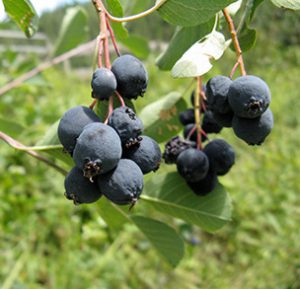
|
Saskatoon ServiceberryHeight: 5m
The Saskatoon Serviceberry is a very hardy, deciduous shrub, which grows numerous lateral and ascending branches giving it a full, rounded shape reaching heights of 5m. Early during the spring, slender pink buds open into small five-petaled flower clusters on the terminal ends of the branches. The flowers open prior to the leaf bud development, turning the plant into a showy, white bush. Over the summer months, the flowers develop into small, pea-sized purple berries. Leaves produced are blue-green, oval-shaped, toothed prominently along the top of the leaf, and arranged alternately along the branches. During autumn, the foliage changes to yellowish-orange or a deep red-purple colour. The Saskatoon Serviceberry is an ideal species to stabilize banks, control erosion, and restore natural areas due to its fibrous root system.
|
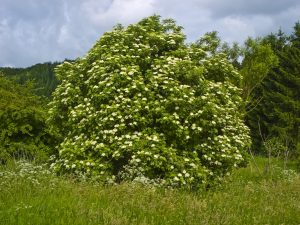
|
Black ElderberryHeight: 4 m
The Black Elderberry is a large, fast-growing, deciduous shrub or small tree, which typically grows to 4m. This species tolerates a variety of conditions and is commonly found in sunny locations with well-drained soils. Black Elderberry can be single or multi-stalked with numerous branches creating a full, round body. Leaves are compound, with 5-7 leaflets that grow opposite each other along the branch. During the fall, leaves tend to turn a pale yellow. During late May to early June, this species produces flowers that are ivory white and grow in flat topped clusters. By late August, flowers turn to glossy, deep purple fruit, which attract a variety of wildlife like songbirds and small mammals. Ripe fruit is edible for humans and is commonly made into jams and jellies. The root system of this species is shallow, and can form colonies through suckering.
|
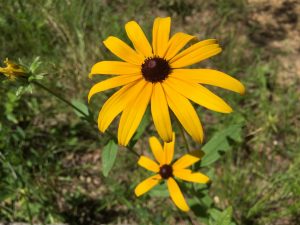
|
Black-Eyed SusanHeight: 1 m
Black-Eyed Susan is a popular biennial or a short-lived perennial wildflower species that typically grows about 1 m in height. Its leaves are green, alternately arranged, lance shaped, and covered with bristly hairs giving the leaf a grey/green colour. The flowers are daisy-like, have 8-20 yellow ray florets surrounding numerous dark brown disk florets, and blooms between June and September. The flowers are beneficial to pollinator species, like bees and butterflies. The seeds are also beneficial to wildlife species, like birds and small mammals. This flower blooms for long periods.
|
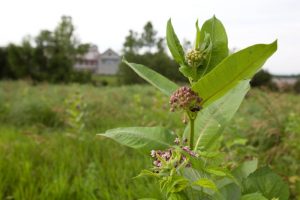
|
Common MilkweedHeight: 1 m
Common Milkweed is a perennial wildflower species that typically grows less than 1 m in height. The stem is thick, green, finely-haired, and tapers slightly towards the top of the plant. The leaves are alternately arranged, large and wide, broadly oblong in shape, and have entire margins. The upper leaf surface is pale-medium to dark green and hairless with a prominent central vein, while the lower leaf surface is densely covered with short hairs. When either the central stem or leaves are torn, a milky sap oozes out. The flowers are whitish pink to reddish purple coloured, have five tiny petals, are fragrant, appear in globe shaped clusters at the top of the plant, and bloom between June and August. The flowers turn into long seedpods that are rounded at one end, pointed at the other end, and covered with soft prickles and short woolly hairs. In the fall, the seedpods split open to release numerous hairy seeds to be dispersed by wind. Common Milkweed is easy to grow and is low maintenance. This wildflower spreads well and can be used to naturalize un-vegetated areas. The roots can be useful for controlling erosion and stabilizing shorelines. The flowers are beneficial to pollinator species, like bees and butterflies. It is also a larval host for caterpillars of the endangered Monarch Butterfly, thus planting this species where possible can help protect this species at risk.
|
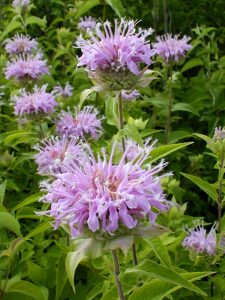
|
Wild BergamotHeight: 1 m
Wild Bergamot is a perennial wildflower species that is member of the mint family and can grow about 1 m tall. Its stems are light green and smooth with abundant branching on the upper half. The leaves are oppositely arranged, broadly lanceolate shaped, 6-10 cm long, and have toothed edges. The also leaves emit a aromatic minty/oregano scent when crushed. The flowers are showy, pink/lavender coloured, appear on the ends of flowering stems, and bloom between July and September. The flowers bloom in the center of the head first, moving outwards creating a wreath. The flowers are beneficial to pollinator species, like bees and butterflies. This wildflower spreads well and can be used to naturalize un-vegetated areas. The roots can be useful for controlling erosion and stabilizing shorelines.
|
Compartment A
Naturalization Area
 Depth: potted, bareroot
Depth: potted, bareroot-
 Moisture: normal
Moisture: normal -
 Soil Type: sandy, loamy
Soil Type: sandy, loamy  Plant Height: max 3m
Plant Height: max 3m-
 Light conditions: full sun, partial sun
Light conditions: full sun, partial sun
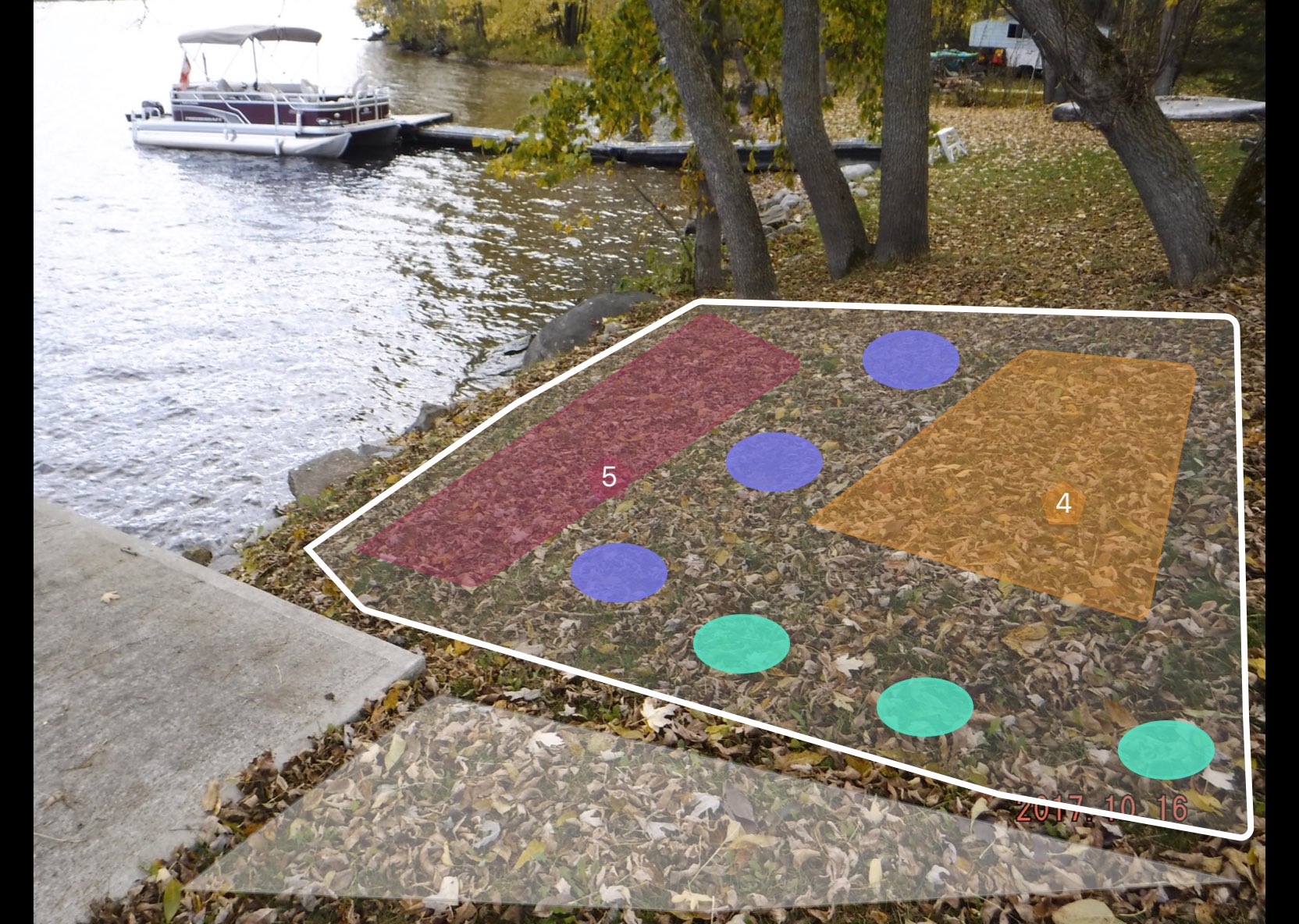
Compartment B
Naturalization Area
 Depth: wildflowers
Depth: wildflowers-
 Moisture: normal
Moisture: normal -
 Soil Type: sandy, loamy
Soil Type: sandy, loamy  Plant Height: max 1.5m
Plant Height: max 1.5m-
 Light conditions: full sun, partial sun
Light conditions: full sun, partial sun
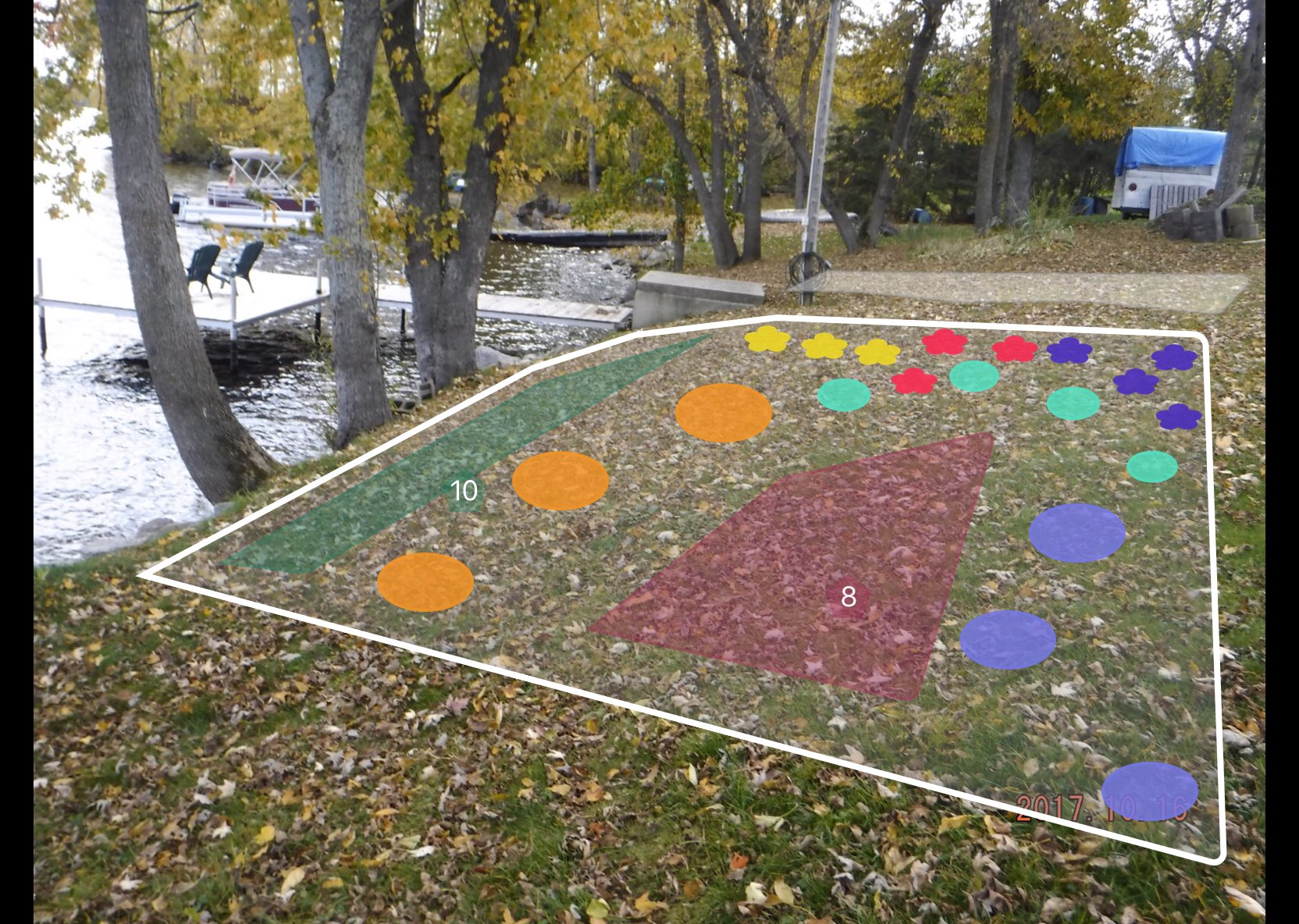
Compartment C
Naturalization Area
 Depth: potted, bareroot, wildflowers
Depth: potted, bareroot, wildflowers-
 Moisture: normal
Moisture: normal -
 Soil Type: sandy, loamy
Soil Type: sandy, loamy  Plant Height: max 3m
Plant Height: max 3m-
 Light conditions: full sun, partial sun
Light conditions: full sun, partial sun
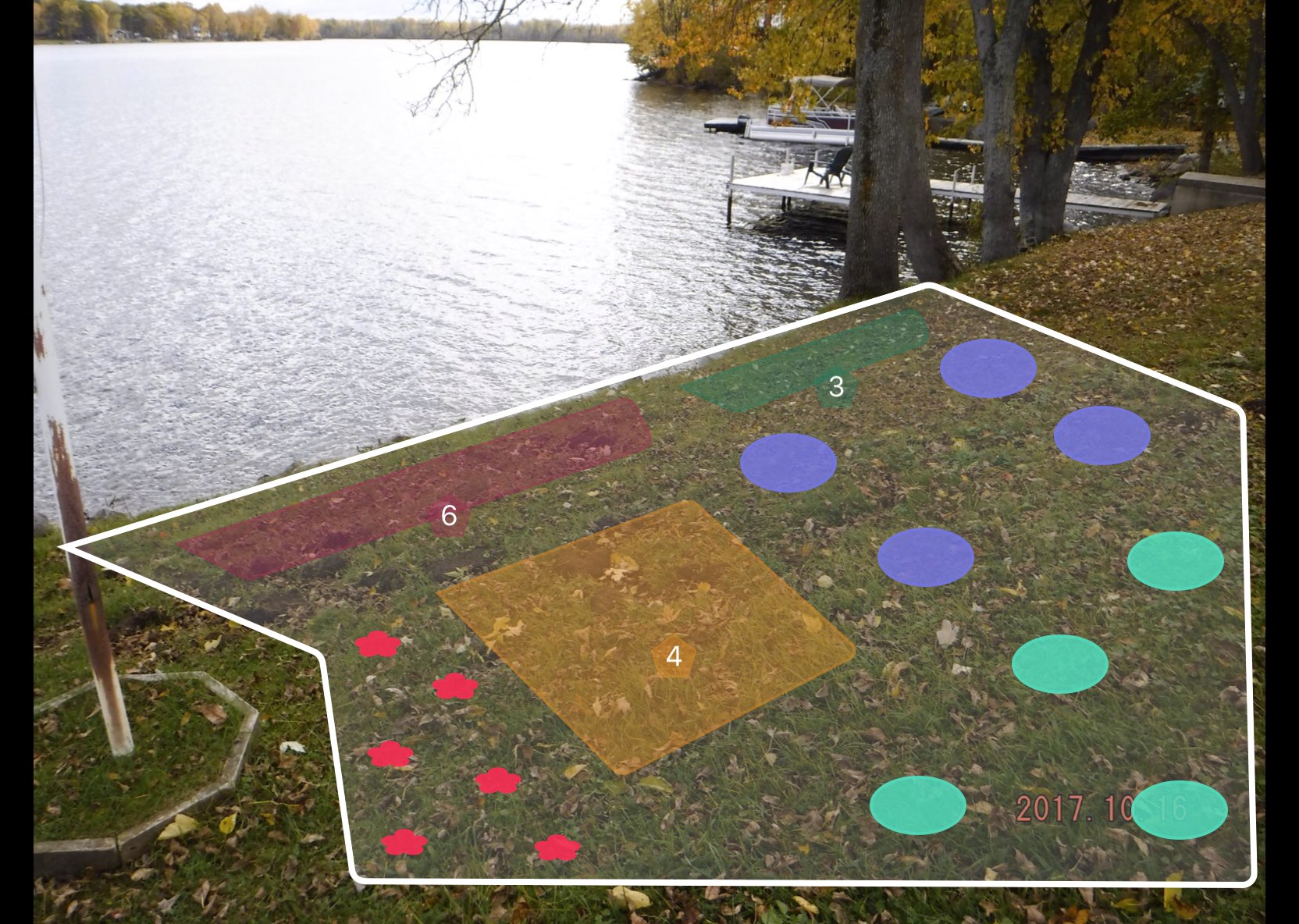
Schedule B
Financial Summary
Project by: Watersheds Canada
Shoreline Re-Naturalization Starter Kit includes: free site visit, customized re-naturalization planting plan for your shoreline property, native plants including free bare root (small) and potted (large) plants and wildflowers, coconut fibre pads to deter grass from growing around new plantings, tree guards for all deciduous trees, mulch for your wildflowers, Plant Care Guide with instructions on how to take care of your new plants, Habitat Creation Guide and a Wildflower Garden Guide.
Our planting plans are created onsite with you and provide detailed information and plans to re-naturalize your shoreline property. We take photos of areas for planting and overlay native plants that are well suited to your property based on site conditions such as soil type and sunlight availability.
We will work with you to create a plan that works for you including options for low growing plants in areas where views are important.
| Item | Quantity | Cost/Item | Subtotal |
|---|---|---|---|
| Starter Kit fee | $395 | ||
| Free potted plants | 15 | $0 | $0 |
| Paid potted plants | 9 | 13.00 | 117.00 |
| Free bareroot plants | 25 | $0 | $0 |
| Paid bareroot plants | 15 | 2.25 | 33.75 |
| Free wildflowers | 10 | $0 | $0 |
| Paid wildflowers | 6 | 6.00 | 36.00 |
| Total costs | 581.75 |
Schedule C
Project Agreement
Stewardship Agreement
Please indicate your agreement to this proposed plan by signing the following Stewardship Agreement and submitting it, along with your financial contribution, to:
Watersheds Canada
115-40 Sunset Blvd. Perth ON K7H 2Y4
Plant Availability
Please note that plant species may need to be changed based on plant stock availability at the time of ordering.
Project Completion
Upon receiving your signed stewardship agreement and financial contribution, a date will be booked for you to pick up your Natural Edge Kit. Watersheds Canada will supply all plants and materials. If you are paying for the planting to be completed for you, a date will be arranged for Watersheds Canada to plant your shoreline, bringing the plants and materials with them. If there are particular dates that you would prefer, we will do our best to accommodate your requests.
The Natural Edge Stewardship Agreement with Watersheds Canada
Agreement made this Day of the Month of in the Year .
BETWEEN Vince Gervais 80 Lacroix Bay Rd, Westmeath Ontario K0J 2L0 (Hereinafter called the OWNERS)
AND Watersheds Canada 115-40 Sunset Blvd. Perth ON K7H 2Y4 (Hereinafter called WC)
WHEREAS the Owners and WC have met and discussed plans for shoreline naturalization on the specified area(s) in Schedule A existing on the Owners’ land;
WHEREAS the Owners indicate approval of the project as proposed; and
WHEREAS the project is, or will be for the benefit of the Owners and others;
NOW THEREFORE THE PARTIES AGREE AS FOLLOWS:
1. This Agreement shall be in effect for a period of 5 years, commencing with the date of this Agreement.
2. The Owners and WC agree that the areas where the work is to be performed is as described in Schedule A.
3. The Owners agree to pick up their Natural Edge Starter Kit from WC’s office and plant their shoreline within two days of receipt. The Owners will provide “after” photos of the work completed to be used for reporting purposes. If the Owners wish to have the planting completed for them, then WC or it’s contractors, employees and agents will complete the planting at cost, as indicated in Schedule B.
4. If the planting is to be completed by WC, then the Owners grant WC, its contractors, employees and agents, the right to enter the property to perform the work agreed upon as outlined in Schedule A. In addition, WC, its contractors, employees and agents may inspect the work performed for the purposes of monitoring the project and survival assessment, with prior agreement with Owners for date and time of inspection.
5. The Owners agree to contribute the “Landowner contribution” and pay the costs indicated in Schedule B.
6. In instances where the Owners are to pay WC for work to be performed (outlined in Schedule A), the Owners agree to provide payments to WC prior to the commencement of that operation. Failure of payment shall constitute a breach of this Agreement and the Owners agree that this Agreement will be terminated and thereupon the Owners agree to pay WC the estimated costs of the operations of the project completed to date, if any.
7. The Owners agree, if necessary, to perform a reasonable amount of maintenance, which is described in the Native Plant Care Guide, available at naturaledge.watersheds.ca.
8. If a contractor is required to perform the work outlined in Schedule A, then the contractor carrying out the work on the land described will be required to take out and furnish evidence of a comprehensive policy of public liability and property damage coverage. The contractor and their workers will be required to be in good standing with the Workplace Safety and Insurance Board (WSIB) prior to performing the work.
9. The Owners agree not to remove, destroy or alter the project without prior consultation and approval of WC. Pruning and trimming planted nursery stock, or adding replacement native nursery stock is exempt.
10. The Owners agree not to mow the planted area.
11. The Owners do acknowledge that WC, its contractors, employees and agents, having performed said works, are not under further obligation with respect to survival of nursery stock, inspection, or maintenance.
12. The Owners, in the absence of negligence, hereby remise, release and forever discharge WC, its contractors, employees and agents from all claims and demands for injuries, including death, loss, damages and costs in any way related to or connected with installation and maintenance of the work described or resulting from any deleterious effects of the work to the land or to the lands and buildings thereon retained by the Owners.
IN WITNESS WHEREOF the parties have agreed to the contents of this plan; SIGNED:
About this program
About Watersheds Canada
Watersheds Canada is a non-profit organization and registered Canadian charity committed to working with landowners, communities, and organizations to protect lakes and rivers through developing effective, transferable, and long-term solutions.
This program was created by Watersheds Canada
We believe that every person has the right to access clean and healthy lakes and rivers in Canada. At Watersheds Canada, we work to keep these precious places naturally clean and healthy for people and wildlife to continue using for years to come. We love working with others to meet the needs of local communities, whether you’re a concerned citizen, a landowner, a lake association looking for help, or a coalition of groups interested in activating your local community.

